BMW MOTORRAD G 650 GS 2010 Rider's Manual (in English)
Manufacturer: BMW MOTORRAD, Model Year: 2010, Model line: G 650 GS, Model: BMW MOTORRAD G 650 GS 2010Pages: 136, PDF Size: 1.73 MB
Page 41 of 136
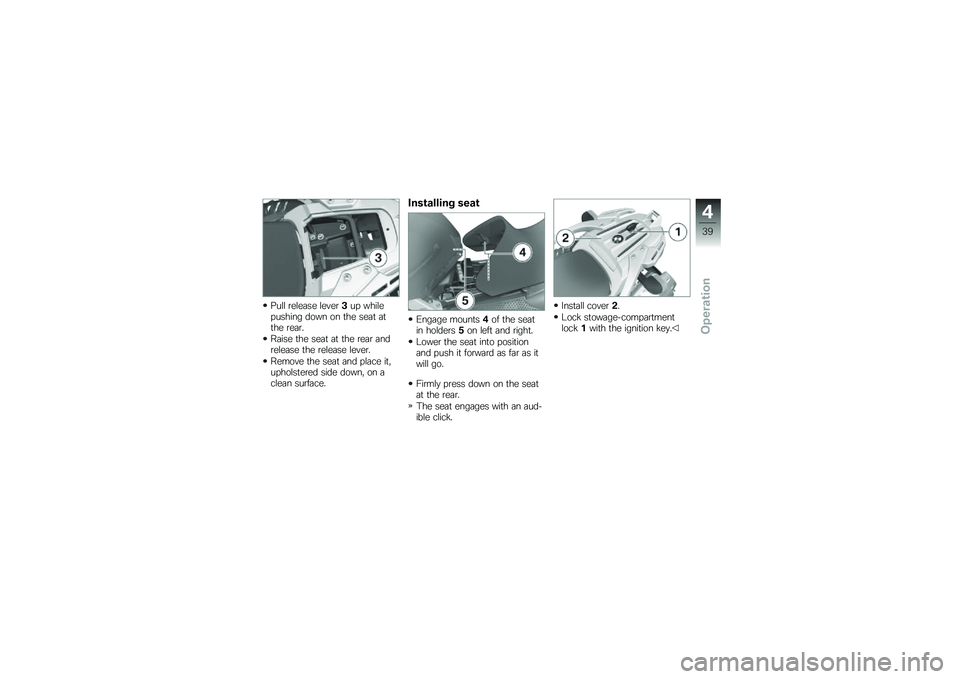
Pull release lever3up whilepushing down on the seat atthe rear.
Raise the seat at the rear andrelease the release lever.
Remove the seat and place it,upholstered side down, on aclean surface.
Installing seat
Engage mounts4of the seatin holders5on left and right.
Lower the seat into positionand push it forward as far as itwill go.
Firmly press down on the seatat the rear.
The seat engages with an aud-ible click.
Install cover2.
Lock stowage-compartmentlock1with the ignition key.
4
39
zOperation
Page 42 of 136

4
40
zOperation
Page 43 of 136
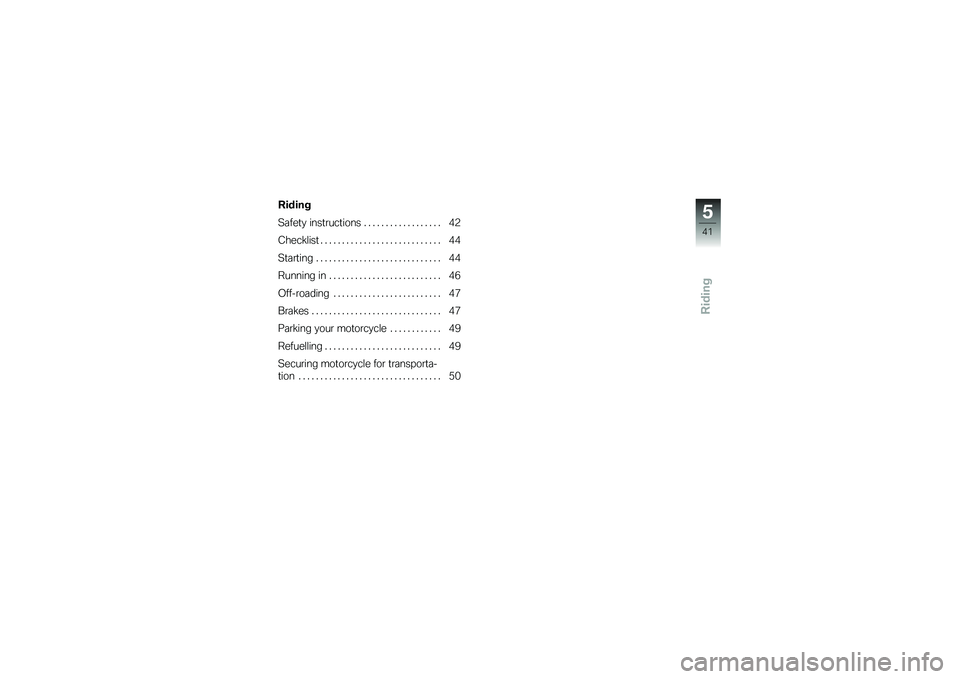
Riding
Riding
Safety instructions . . . . . . . . . . . . . . . . . . 42
Checklist . . . . . . . . . . . . . . . . . . . . . . . . . . . . 44
Starting . . . . . . . . . . . . . . . . . . . . . . . . . . . . . 44
Running in . . . . . . . . . . . . . . . . . . . . . . . . . . 46
Off-roading . . . . . . . . . . . . . . . . . . . . . . . . . 47
Brakes . . . . . . . . . . . . . . . . . . . . . . . . . . . . . . 47
Parking your motorcycle . . . . . . . . . . . . 49
Refuelling . . . . . . . . . . . . . . . . . . . . . . . . . . . 49
Securing motorcycle for transporta-
tion . . . . . . . . . . . . . . . . . . . . . . . . . . . . . . . . . 50
5
41
zRiding
Page 44 of 136
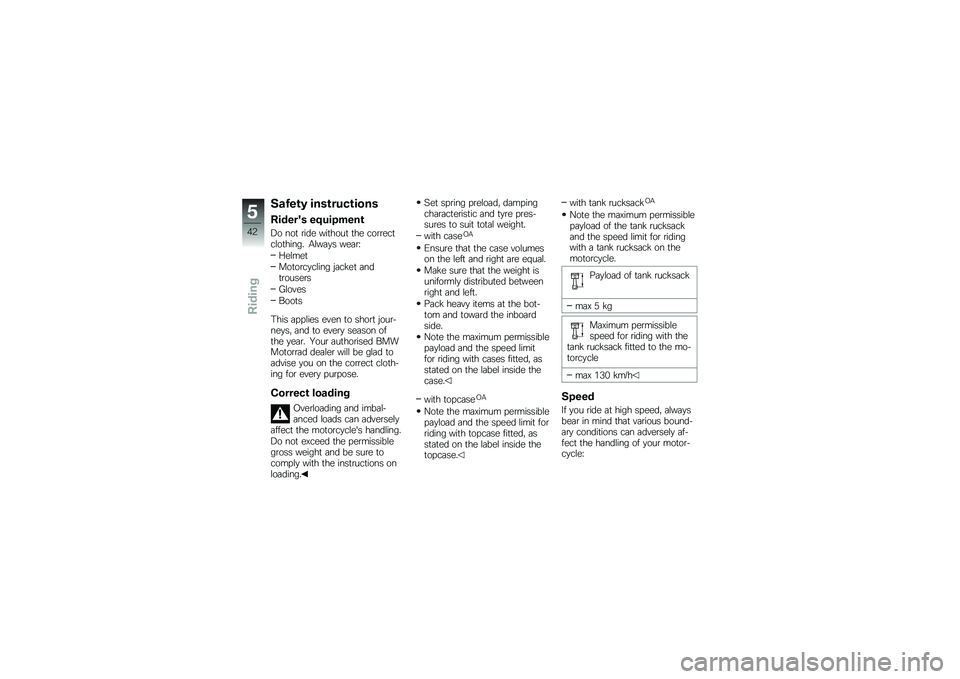
Safety instructions
Rider's equipment
Do not ride without the correctclothing. Always wear:
Helmet
Motorcycling jacket andtrousers
Gloves
Boots
This applies even to short jour-neys, and to every season ofthe year. Your authorised BMWMotorrad dealer will be glad toadvise you on the correct cloth-ing for every purpose.
Correct loading
Overloading and imbal-anced loads can adverselyaffect the motorcycle's handling.
Do not exceed the permissiblegross weight and be sure tocomply with the instructions onloading.
Set spring preload, dampingcharacteristic and tyre pres-sures to suit total weight.
with caseOA
Ensure that the case volumeson the left and right are equal.
Make sure that the weight isuniformly distributed betweenright and left.
Pack heavy items at the bot-tom and toward the inboardside.
Note the maximum permissiblepayload and the speed limitfor riding with cases fitted, asstated on the label inside thecase.
with topcaseOA
Note the maximum permissiblepayload and the speed limit forriding with topcase fitted, asstated on the label inside thetopcase.
with tank rucksackOA
Note the maximum permissiblepayload of the tank rucksackand the speed limit for ridingwith a tank rucksack on themotorcycle.
Payload of tank rucksack
max 5 kg
Maximum permissiblespeed for riding with thetank rucksack fitted to the mo-torcycle
max 130 km/h
Speed
If you ride at high speed, alwaysbear in mind that various bound-ary conditions can adversely af-fect the handling of your motor-cycle:
5
42
zRiding
Page 45 of 136
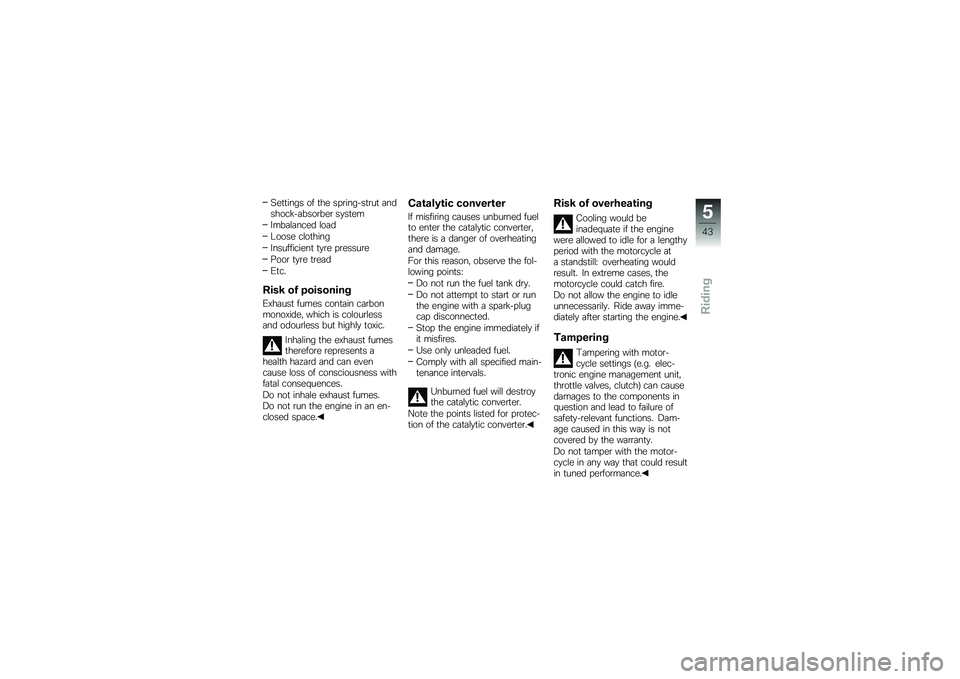
Settings of the spring-strut andshock-absorber system
Imbalanced load
Loose clothing
Insufficient tyre pressure
Poor tyre tread
Etc.
Risk of poisoning
Exhaust fumes contain carbonmonoxide, which is colourlessand odourless but highly toxic.
Inhaling the exhaust fumestherefore represents ahealth hazard and can evencause loss of consciousness withfatal consequences.
Do not inhale exhaust fumes.Do not run the engine in an en-closed space.
Catalytic converter
If misfiring causes unburned fuelto enter the catalytic converter,there is a danger of overheatingand damage.
For this reason, observe the fol-lowing points:
Do not run the fuel tank dry.
Do not attempt to start or runthe engine with a spark-plugcap disconnected.
Stop the engine immediately ifit misfires.
Use only unleaded fuel.
Comply with all specified main-tenance intervals.
Unburned fuel will destroythe catalytic converter.
Note the points listed for protec-tion of the catalytic converter.
Risk of overheating
Cooling would beinadequate if the enginewere allowed to idle for a lengthyperiod with the motorcycle ata standstill: overheating wouldresult. In extreme cases, themotorcycle could catch fire.
Do not allow the engine to idleunnecessarily. Ride away imme-diately after starting the engine.
Tampering
Tampering with motor-cycle settings (e.g. elec-tronic engine management unit,throttle valves, clutch) can causedamages to the components inquestion and lead to failure ofsafety-relevant functions. Dam-age caused in this way is notcovered by the warranty.
Do not tamper with the motor-cycle in any way that could resultin tuned performance.
5
43
zRiding
Page 46 of 136
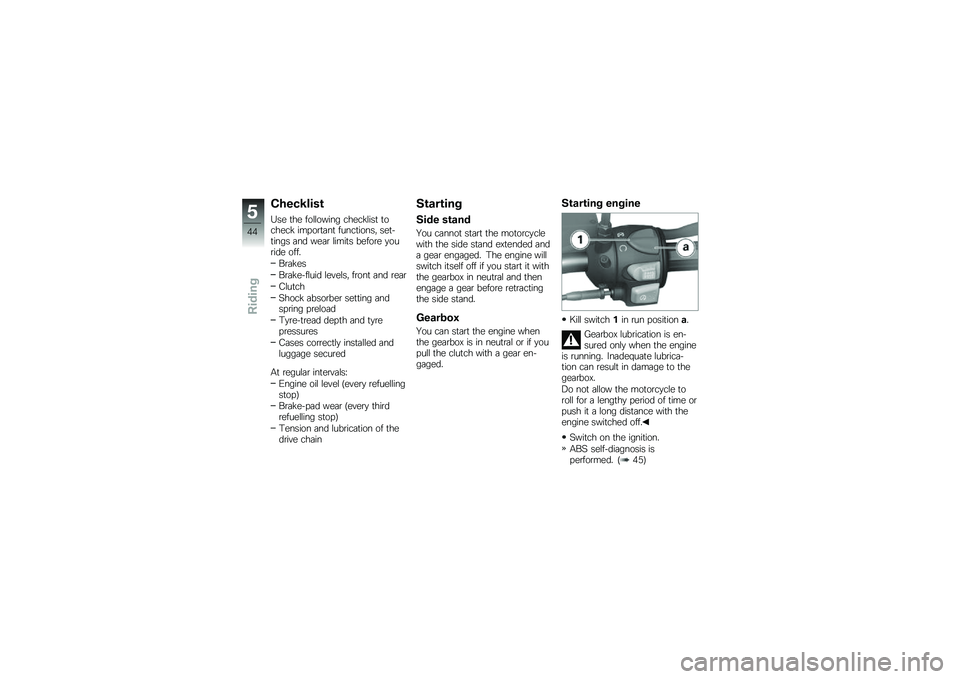
Checklist
Use the following checklist tocheck important functions, set-tings and wear limits before youride off.
Brakes
Brake-fluid levels, front and rear
Clutch
Shock absorber setting andspring preload
Tyre-tread depth and tyrepressures
Cases correctly installed andluggage secured
At regular intervals:
Engine oil level (every refuellingstop)
Brake-pad wear (every thirdrefuelling stop)
Tension and lubrication of thedrive chain
Starting
Side stand
You cannot start the motorcyclewith the side stand extended anda gear engaged. The engine willswitch itself off if you start it withthe gearbox in neutral and thenengage a gear before retractingthe side stand.
Gearbox
You can start the engine whenthe gearbox is in neutral or if youpull the clutch with a gear en-gaged.
Starting engine
Kill switch1in run positiona.
Gearbox lubrication is en-sured only when the engineis running. Inadequate lubrica-tion can result in damage to thegearbox.
Do not allow the motorcycle toroll for a lengthy period of time orpush it a long distance with theengine switched off.
Switch on the ignition.
ABS self-diagnosis isperformed. (45)
5
44
zRiding
Page 47 of 136
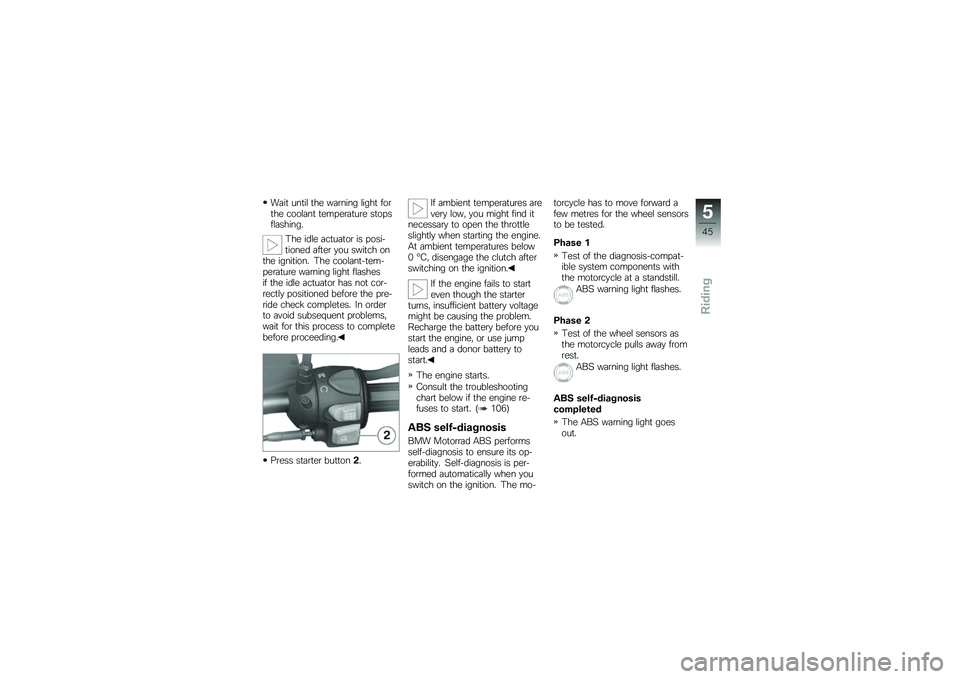
Wait until the warning light forthe coolant temperature stopsflashing.
The idle actuator is posi-tioned after you switch onthe ignition. The coolant-tem-perature warning light flashesif the idle actuator has not cor-rectly positioned before the pre-ride check completes. In orderto avoid subsequent problems,wait for this process to completebefore proceeding.
Press starter button2.
If ambient temperatures arevery low, you might find itnecessary to open the throttleslightly when starting the engine.At ambient temperatures below0 °C, disengage the clutch afterswitching on the ignition.
If the engine fails to starteven though the starterturns, insufficient battery voltagemight be causing the problem.Recharge the battery before youstart the engine, or use jumpleads and a donor battery tostart.
The engine starts.
Consult the troubleshootingchart below if the engine re-fuses to start. (106)
ABS self-diagnosis
BMW Motorrad ABS performsself-diagnosis to ensure its op-erability. Self-diagnosis is per-formed automatically when youswitch on the ignition. The mo-
torcycle has to move forward afew metres for the wheel sensorsto be tested.
Phase 1
Test of the diagnosis-compat-ible system components withthe motorcycle at a standstill.
ABS warning light flashes.
Phase 2
Test of the wheel sensors asthe motorcycle pulls away fromrest.
ABS warning light flashes.
ABS self-diagnosiscompleted
The ABS warning light goesout.
5
45
zRiding
Page 48 of 136
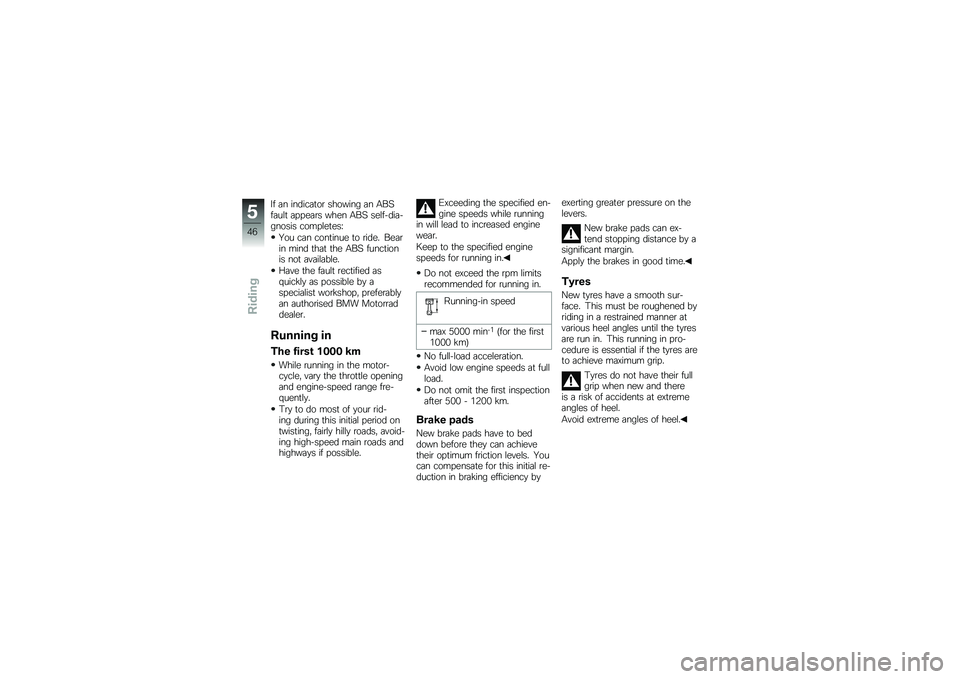
If an indicator showing an ABSfault appears when ABS self-dia-gnosis completes:
You can continue to ride. Bearin mind that the ABS functionis not available.
Have the fault rectified asquickly as possible by aspecialist workshop, preferablyan authorised BMW Motorraddealer.
Running in
The first 1000 km
While running in the motor-cycle, vary the throttle openingand engine-speed range fre-quently.
Try to do most of your rid-ing during this initial period ontwisting, fairly hilly roads, avoid-ing high-speed main roads andhighways if possible.
Exceeding the specified en-gine speeds while runningin will lead to increased enginewear.
Keep to the specified enginespeeds for running in.
Do not exceed the rpm limitsrecommended for running in.
Running-in speed
max 5000 min-1(for the first1000 km)
No full-load acceleration.
Avoid low engine speeds at fullload.
Do not omit the first inspectionafter 500 - 1200 km.
Brake pads
New brake pads have to beddown before they can achievetheir optimum friction levels. Youcan compensate for this initial re-duction in braking efficiency by
exerting greater pressure on thelevers.
New brake pads can ex-tend stopping distance by asignificant margin.
Apply the brakes in good time.
Tyres
New tyres have a smooth sur-face. This must be roughened byriding in a restrained manner atvarious heel angles until the tyresare run in. This running in pro-cedure is essential if the tyres areto achieve maximum grip.
Tyres do not have their fullgrip when new and thereis a risk of accidents at extremeangles of heel.
Avoid extreme angles of heel.
5
46
zRiding
Page 49 of 136
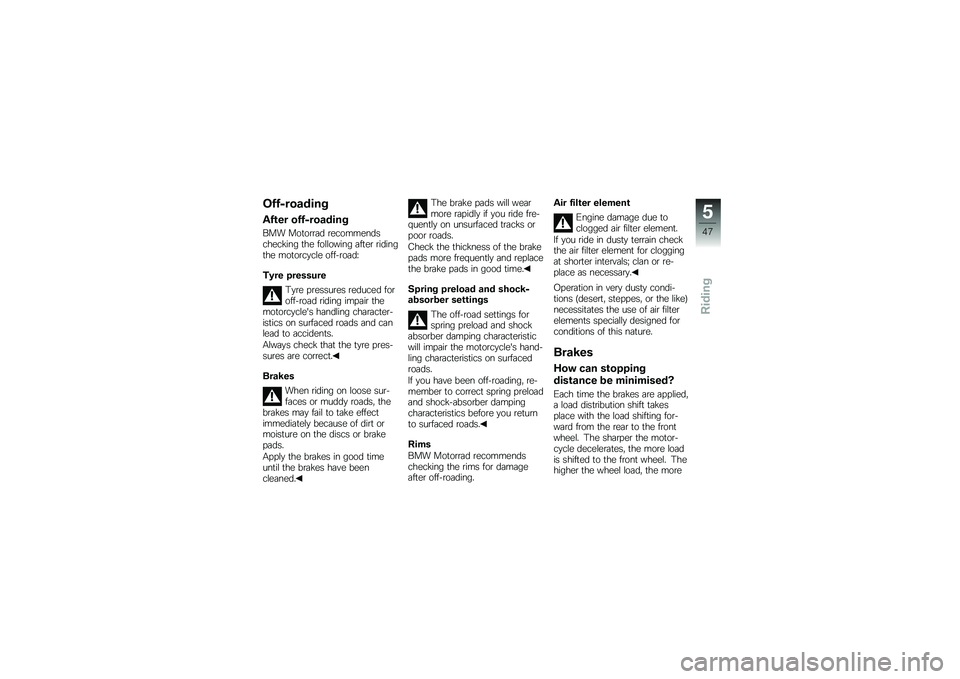
Off-roading
After off-roading
BMW Motorrad recommendschecking the following after ridingthe motorcycle off-road:
Tyre pressure
Tyre pressures reduced foroff-road riding impair themotorcycle's handling character-istics on surfaced roads and canlead to accidents.
Always check that the tyre pres-sures are correct.
Brakes
When riding on loose sur-faces or muddy roads, thebrakes may fail to take effectimmediately because of dirt ormoisture on the discs or brakepads.
Apply the brakes in good timeuntil the brakes have beencleaned.
The brake pads will wearmore rapidly if you ride fre-quently on unsurfaced tracks orpoor roads.
Check the thickness of the brakepads more frequently and replacethe brake pads in good time.
Spring preload and shock-absorber settings
The off-road settings forspring preload and shockabsorber damping characteristicwill impair the motorcycle's hand-ling characteristics on surfacedroads.
If you have been off-roading, re-member to correct spring preloadand shock-absorber dampingcharacteristics before you returnto surfaced roads.
Rims
BMW Motorrad recommendschecking the rims for damageafter off-roading.
Air filter element
Engine damage due toclogged air filter element.
If you ride in dusty terrain checkthe air filter element for cloggingat shorter intervals; clan or re-place as necessary.
Operation in very dusty condi-tions (desert, steppes, or the like)necessitates the use of air filterelements specially designed forconditions of this nature.
Brakes
How can stopping
distance be minimised?
Each time the brakes are applied,a load distribution shift takesplace with the load shifting for-ward from the rear to the frontwheel. The sharper the motor-cycle decelerates, the more loadis shifted to the front wheel. Thehigher the wheel load, the more
5
47
zRiding
Page 50 of 136
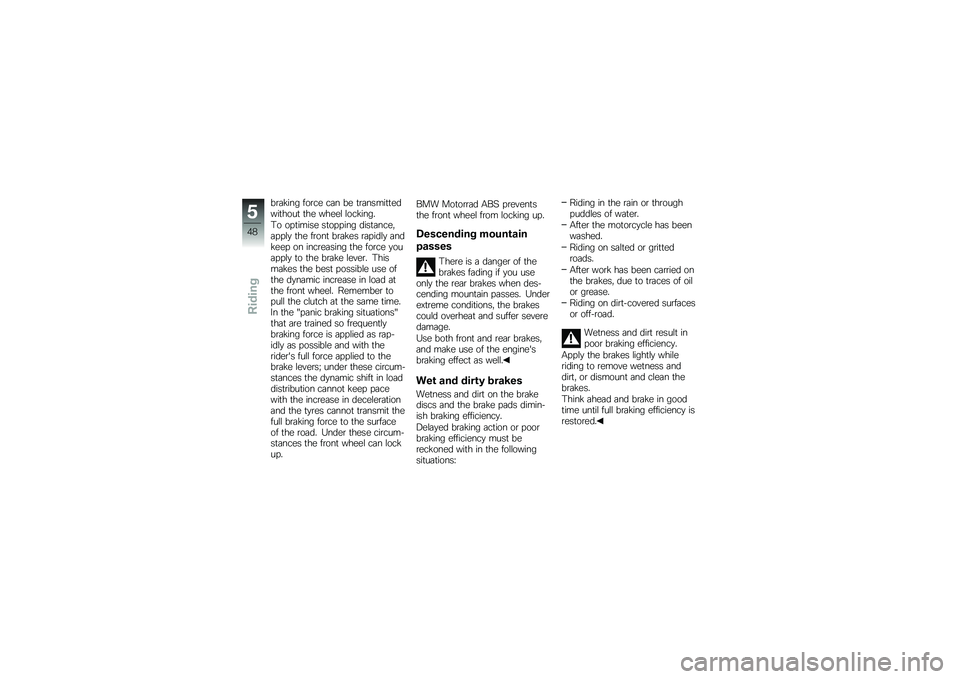
braking force can be transmittedwithout the wheel locking.
To optimise stopping distance,apply the front brakes rapidly andkeep on increasing the force youapply to the brake lever. Thismakes the best possible use ofthe dynamic increase in load atthe front wheel. Remember topull the clutch at the same time.In the "panic braking situations"that are trained so frequentlybraking force is applied as rap-idly as possible and with therider's full force applied to thebrake levers; under these circum-stances the dynamic shift in loaddistribution cannot keep pacewith the increase in decelerationand the tyres cannot transmit thefull braking force to the surfaceof the road. Under these circum-stances the front wheel can lockup.
BMW Motorrad ABS preventsthe front wheel from locking up.
Descending mountain
passes
There is a danger of thebrakes fading if you useonly the rear brakes when des-cending mountain passes. Underextreme conditions, the brakescould overheat and suffer severedamage.
Use both front and rear brakes,and make use of the engine'sbraking effect as well.
Wet and dirty brakes
Wetness and dirt on the brakediscs and the brake pads dimin-ish braking efficiency.
Delayed braking action or poorbraking efficiency must bereckoned with in the followingsituations:
Riding in the rain or throughpuddles of water.
After the motorcycle has beenwashed.
Riding on salted or grittedroads.
After work has been carried onthe brakes, due to traces of oilor grease.
Riding on dirt-covered surfacesor off-road.
Wetness and dirt result inpoor braking efficiency.
Apply the brakes lightly whileriding to remove wetness anddirt, or dismount and clean thebrakes.
Think ahead and brake in goodtime until full braking efficiency isrestored.
5
48
zRiding